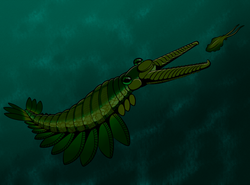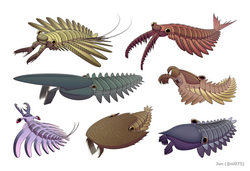카리오신트립스
|
| ||
|---|---|---|
| 화석 범위: 캄브리아기 중기 | ||
 카리오신트립스의 전방부속지 | ||
 방사치목으로 추정했을 때의 복원도 | ||
| 생물 분류ℹ️ | ||
| 계: | 동물계 | |
| 문: | 절지동물문 | |
| 속: | †카리오신트립스속 (Caryosyntrips) Daley & Budd, 2010 | |
| 모식종 | ||
| †Caryosyntrips serratus | ||
| Daley & Budd, 2010 | ||
학명이명 | ||
| ||
| 종 | ||
| ||
카리오신트립스(학명: Caryosyntrips , →호두까기)는 캄브리아기 중기 캐나다, 미국, 스페인에서 발견된 절지동물의 멸종한 속이다.[2] 2010년 앨리슨 C. 데일리(Allison C. Daley)와 그레이엄 E. 버드(Graham E. Budd)에 의해 카리오신트립스 세라투스(Caryosyntrips serratus)가 모식종으로 처음 명명되었다.[3]
어원
[편집]속명 카리오신트립스(Caryosyntrips)는 그리스어로 '견과류'를 뜻하는 '카리온(karyon)'과, '부수는 자'라는 의미를 가지고 있으며 그리스 신화의 도자기 정령(고대 그리스어: Δαίμονες Κεραμικοί 다이모네스 케라미코이[*]) 중의 하나인 신트립스(고대 그리스어: Σύντριψ)에서 유래했다.[3]
발견
[편집]대부분의 종이 캐나다의 버지스 셰일, 미국의 휠러 셰일과 마줌층, 스페인의 발데미데스층에서 발견되었다.[2][4] 후자에는 처음에 엽족동물(학명: Mureropodia apae 무레로포디아 아파이[*])의 몸체 잔해로 잘못 동정된 대형 표본이 포함되어 있다.[1][2][5][6] 무레로포디아(Mureropodia)의 잘못된 부속지 배치로 논란이 생겼지만,[7] 이전 엽족동물과의 친연성은 해당 화석이 카리오신트립스의 부속지인 것보다 설득력이 더 떨어졌다.[6]
생김새
[편집]-
C. serratus의 전방부속지 화석
-
C. camurus의 전방부속지 화석
-
C. durus의 전방부속지 화석
-
C. cf. camurus (=Mureropodia apae)의 전방부속지 화석
-
C. cf. camarus (=Mureropodia apae)의 디지털 개선 이미지
-
C. camurus가 했을 것으로 추정되는 포획 동작
-
방사치목으로 해석된 다양한 카리오신트립스 표본의 크기[6]
카리오신트립스는 14개의 마디로 이루어진 전방부속지만이 밝혀져 있으며, 이 전방부속지는 호두까기처럼 생겼고, 안쪽돌기(밑가시)가 달린 가장자리부가 서로 마주보고 있으며, 종 모양의 기부는 동물의 머리와 연결된 가동되는 관절에 해당할 가능성이 있다.[2] 안쪽돌기, 끝가시, 체절 경계부 및 바깥 가장자리의 세밀 부위는 종마다 다르다.[2] 카리오신트립스는 전방부속지를 가위처럼 잡거나 자르는 동작에 사용하여 단단한 껍질을 가진 생물을 먹이로 삼았을 것으로 추정된다.[2] 이 밖에 다른 구조는 알려져 있지 않지만, 한 쌍의 부속지를 가진 표본의 경우 다른 단편적인 머리경판도 포함되어 있을 수 있다.[3][4]
카리오신트립스의 크기는 종마다 다르다. 가장 큰 종은 C. serratus로, 길이는 약 20.5~30.2cm로 추정된다. 다른 종들은 훨씬 작아서, C. camurus와 C. durus의 경우 몸길이는 각각 13.7~20.2cm와 12.2~17.9cm로 추정된다. 가장 큰 표본(MPZ 2009/1241)은 C. cf. camurus로 동정되며, 길이는 36.7~54cm인 개체에 속했을 것이다.[8]
분류 유연 관계
[편집]2010년대에 카리오신트립스는 오랫동안 불확실한 위치의 기저 방사치목으로 간주되었으며, 보통 진절지동물과 방사치목 계통 사이의 다분할류로 풀이되었다.[9][10][11][6][12][13] 그러나 최근 논문들에 따르면 카리오신트립스는 단계통군인 방사치목의 바깥에 위치할 수 있음을 발견했다.[13][14] 전방부속지의 특이한 형태와 발견된 잔여물의 제한적인 범위 때문에 절지동물 줄기군 내에서의 위치는 여전히 불확실하다.[2][14]
| 범절지동물 |
| |||||||||||||||||||||||||||||||||
| Panarthropoda |
각주
[편집]- ↑ 가 나 Gámez Vintaned; José Antonio; Liñán, Eladio; Yu. Zhuravlev, Andrey (2011), Pontarotti, Pierre, 편집., “A New Early Cambrian Lobopod-Bearing Animal (Murero, Spain) and the Problem of the Ecdysozoan Early Diversification”, 《Evolutionary Biology – Concepts, Biodiversity, Macroevolution and Genome Evolution》 (영어) (Berlin, Heidelberg: Springer), 193–219쪽, doi:10.1007/978-3-642-20763-1_12, ISBN 978-3-642-20763-1, 2024년 1월 5일에 확인함
- ↑ 가 나 다 라 마 바 사 아 자 Stephen Pates; Allison C. Daley (2017). “Caryosyntrips: a radiodontan from the Cambrian of Spain, USA and Canada”. 《Papers in Palaeontology》 3 (3): 461–470. Bibcode:2017PPal....3..461P. doi:10.1002/spp2.1084. S2CID 135026011.
- ↑ 가 나 다 Allison C. Daley; Graham E. Budd (2010). “New anomalocaridid appendages from the Burgess Shale, Canada”. 《Palaeontology》 53 (4): 721–738. Bibcode:2010Palgy..53..721D. doi:10.1111/j.1475-4983.2010.00955.x.
- ↑ 가 나 Pates, Stephen; Lerosey-Aubril, Rudy; Daley, Allison C.; Kier, Carlo; Bonino, Enrico; Ortega-Hernández, Javier (2021년 1월 19일). “The diverse radiodont fauna from the Marjum Formation of Utah, USA (Cambrian: Drumian)”. 《PeerJ》 (영어) 9. doi:10.7717/peerj.10509. ISSN 2167-8359. PMC 7821760. PMID 33552709.
- ↑ Pates, Stephen; Daley, Allison; Ortega-Hernández, Javier (2018). “Response to Comment on "Aysheaia prolata from the Utah Wheeler Formation (Drumian, Cambrian) is a frontal appendage of the radiodontan Stanleycaris" with the formal description of Stanleycaris”. 《Acta Palaeontologica Polonica》 (영어) 63. doi:10.4202/app.00443.2017. ISSN 0567-7920.
- ↑ 가 나 다 라 Lerosey-Aubril, Rudy; Pates, Stephen (2018년 9월 14일). “New suspension-feeding radiodont suggests evolution of microplanktivory in Cambrian macronekton”. 《Nature Communications》 (영어) 9 (1): 3774. Bibcode:2018NatCo...9.3774L. doi:10.1038/s41467-018-06229-7. ISSN 2041-1723. PMC 6138677. PMID 30218075.
- ↑ José A. Gámez Vintaned; Andrey Y. Zhuravlev (2018). “Comment on "Aysheaia prolata from the Utah Wheeler Formation (Drumian, Cambrian) is a frontal appendage of the radiodontan Stanleycaris" by Stephen Pates, Allison C. Daley, and Javier Ortega-Hernández”. 《Acta Palaeontologica Polonica》 63 (1): 103–104. doi:10.4202/app.00335.2017 (년 이후로 접속 불가 2025-07-11).
- ↑ Lerosey-Aubril, Rudy; Pates, Stephen (2018년 9월 14일). “New suspension-feeding radiodont suggests evolution of microplanktivory in Cambrian macronekton”. 《Nature Communications》 9 (1): 3774. Bibcode:2018NatCo...9.3774L. doi:10.41467/s41467-018-06229-7. ISSN 2041-1723. PMC 6138677. PMID 30218075. Dryad Data
- ↑ Jakob Vinther; Martin Stein; Nicholas R. Longrich; David A. T. Harper (2014). “A suspension-feeding anomalocarid from the Early Cambrian” (PDF). 《Nature》 507 (7493): 496–499. Bibcode:2014Natur.507..496V. doi:10.1038/nature13010. PMID 24670770. S2CID 205237459.
- ↑ Cong, Peiyun; Ma, Xiaoya; Hou, Xianguang; Edgecombe, Gregory D.; Strausfeld, Nicholas J. (September 2014). “Brain structure resolves the segmental affinity of anomalocaridid appendages”. 《Nature》 (영어) 513 (7519): 538–542. Bibcode:2014Natur.513..538C. doi:10.1038/nature13486. ISSN 1476-4687. PMID 25043032. S2CID 4451239.
- ↑ Van Roy, Peter; Daley, Allison C.; Briggs, Derek E. G. (June 2015). “Anomalocaridid trunk limb homology revealed by a giant filter-feeder with paired flaps”. 《Nature》 (영어) 522 (7554): 77–80. Bibcode:2015Natur.522...77V. doi:10.1038/nature14256. ISSN 1476-4687. PMID 25762145. S2CID 205242881.
- ↑ Liu, Jianni; Lerosey-Aubril, Rudy; Steiner, Michael; Dunlop, Jason A; Shu, Degan; Paterson, John R (2018년 6월 1일). “Origin of raptorial feeding in juvenile euarthropods revealed by a Cambrian radiodontan”. 《National Science Review》 5 (6): 863–869. doi:10.1093/nsr/nwy057. ISSN 2095-5138.
- ↑ 가 나 Moysiuk, J.; Caron, J.-B. (2019년 8월 14일). “A new hurdiid radiodont from the Burgess Shale evinces the exploitation of Cambrian infaunal food sources”. 《Proceedings of the Royal Society B: Biological Sciences》 (영어) 286 (1908): 20191079. doi:10.1098/rspb.2019.1079. ISSN 0962-8452. PMC 6710600. PMID 31362637.
- ↑ 가 나 McCall, Christian (2023년 12월 13일). “A large pelagic lobopodian from the Cambrian Pioche Shale of Nevada”. 《Journal of Paleontology》 97 (5): 1009–1024. Bibcode:2023JPal...97.1009M. doi:10.1017/jpa.2023.63. S2CID 266292707. 2023년 12월 13일에 확인함.
외부 링크
[편집]- “Caryosyntrips serratus”. 《Burgess Shale Fossil Gallery》. Virtual Museum of Canada. 2011. 2023년 3월 23일에 원본 문서에서 보존된 문서.







![방사치목으로 해석된 다양한 카리오신트립스 표본의 크기[6]](https://upload.wikimedia.org/wikipedia/commons/thumb/1/13/20210215_Caryosyntrips_size.png/250px-20210215_Caryosyntrips_size.png)
